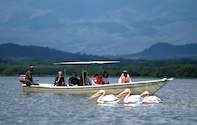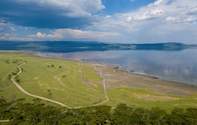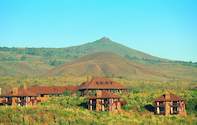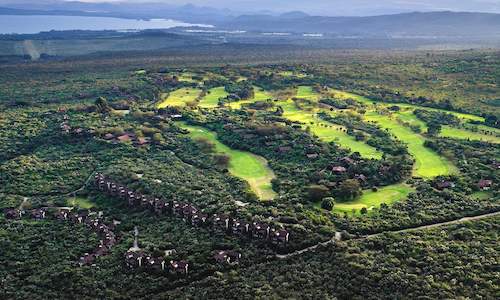
The Great Rift Valley is a perplexing place and always has been. People have lived here since there were people, and pre-humans (as well as the ancestors of the great apes) before that.
The rifting created great troughs where water collected and the volcanoes that accompanied the faulting spewed out wonderfully fertile soils. It was all anyone, or any animal could ask for and life has consequently thrived there. But the Great Rift Valley is not one thing, rather it is a confounding geological phenomenon; it has been described as "lots of rifts" but even that does not adequately define the interconnecting complex of faults and grabens that dice up much of east Africa.
There are two main systems of deep earth trenches in East Africa: the main, Eastern or Gregory Rifts and the Western or Albertine Rift. The two branches look like upstretched arms separated by the 1,300-kilometre wide East African Plateau on which lies the largest of Africa's great lakes, Lake Victoria.
The Albertine Rift is flanked by some of the highest mountains in Africa including the glacier-chiseled Ruwenzori, or Mountains of the Moon, and holds most of the biggest lakes including Lake Tanganyika, the longest and second deepest freshwater body on the planet.
Other significant lakes of this system include Edward, Albert and Kivu. Being discrete, deep and freshwater systems, these great lakes are home to an extraordinary number and diversity of freshwater fishes. There are around 1,500 species of cichlids and another eight major fish families, which together with the cichlids represent the backbone of the world's freshwater aquarium trade today. However, it is the Gregory Rift that is the more extensive and the one most associated with the concept of a "great rift valley".
Tearing Itself Apart

In reality the entire rift system spans some 6,000 kilometres, from Syria in the Middle East to central Mozambique, with tail ends running like the strands of a frayed rope into the Zambezi River valley to beneath the vast sand bowl on which lies the Okavango Delta in Botswana. The "elbow" of the Red Sea is known to geologists as the Afar Triple Junction where two geological plates, the Nubian and the Somali, are busy tearing apart and splitting Africa in two.
Rifting started around 40 million years ago in the north, spreading through central Kenya around 15 million years ago, with the last significant faulting in northern Tanzania about eight million years ago. The widening of the rift is continuing at a rate of between six and seven centimetres a year.
It is estimated that in around 10 million years time the Somali Plate will shear off and a new ocean basin will begin to develop where today zebras and antelope graze. But, at least for the moment, the process does appear to be slowing because most of the volcanoes that line the valley, including Mount Kilimanjaro and the Ngorongoro Crater, are long dormant.
One, however, 01 Doinyo Lengai (the "mountain of god" in Maasai) has blown its top a few times in historical times. The last significant eruptions were in 2008, but it oozes lava pretty much continuously.
The Eastern Rift was named in honour of British explorer John Walter Gregory who, in 1893, coined the term "great rift valley". The first person to recognise it for what it was, however, was the geologist Joseph Thomson who explored the region in 1879-80 as part of a Royal Geographical Society sponsored expedition.
Thomson described the landscape at Lake Baringo thus: "Imagine if you can, a trough or depression 3,300 feet above sea level, and twenty miles broad, the mountains rising with very great abruptness on both sides to a height of 9,000 feet".
Thompson, being a geologist and perhaps having become somewhat jaded by the amazing wildlife sights, forgot to mention in his reports how the shores of lakes such as Nakuru and Naivasha teemed with elephants, buffaloes, leopards and lions, and all manner of beasts and birds of the East African savanna.
The Great Rift Valley Lodge

The Great Rift Valley Lodge is an oasis of considered greenery, as much in the midsts of a decidedly disordered African background. Rift Valley Lodge is ideally located on Mount Eburru, called Ol Donyo Opurru by the Maasai, which means "the mountain of smoke". The lodge is more like a country, or bush hotel, and by far the most comfortable place to stay in the region. Everything about it impressed us way beyond expectations. The service delivery and attention to detail is on par with anything we have experienced anywhere in Africa.
Great Rift Valley Lodge has luxuriant "hanging" gardens that cascade down the many slopes and are most impressive with an array of indigenous trees, shrubs and flowers. Each chalet is situated among verdant greenery with generous views over the Green Eco Park in which it is situated. The vistas extend across Lake Naivasha, the largest of the Rift Valley lakes in the area, and towards the spectacular dormant Qolcano, Mount Longonot.
At an elevation of 7,000 ft the lodge experiences a moderate climate, which is ideal for outdoor activities. The 18-hole golf course has magnificent greens and golfers are expected to avoid hitting the zebras! Great Rift Valley Lodge has received its fair share of accolades and is in every respect a very stylish destination.
By David Bristow

 Great Rift Valley Lodge and Golf Resort perched above Lake Naivasha is the ideal base from which to explore the beauty and diversity of the...
Great Rift Valley Lodge and Golf Resort perched above Lake Naivasha is the ideal base from which to explore the beauty and diversity of the...